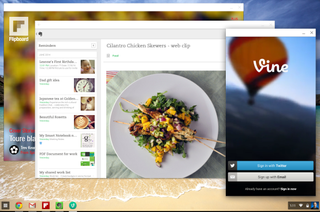Google Brings First Android Apps To ChromeOS

Earlier this year at the Google I/O 2014 event, Google announced that it's going to make Android apps work on top of ChromeOS, its (mostly) web-based operating system. This move would potentially bring many new native apps to ChromeOS, which could be used even when the Chromebook doesn't have an Internet connection.
At I/O, Google said this was still an experiment, but it now seems ready to launch the first Android apps on top of ChromeOS. So far there are only four of them, but Google says no porting is required, which means developers should be able to just make their Android apps available for ChromeOS through the Chrome Web Store without any changes.
The current four apps are: Duolingo, Evernote, Sight Words, and Vine. Flipboard, which was also one of the apps demoed at Google I/O, is nowhere to be seen in this announcement. The apps can now be installed on Chromebooks through the Chrome Web Store, thanks to a project called the App Runtime for Chrome, which is still currently in beta.
That it's in beta may explain why Google continues to say that it will be working with more developers to port their apps to ChromeOS, despite also saying Android apps will work without any changes.

Google has been taking advantage of the fact that over the past decade, more and more people have switched from native desktop apps to web apps. Some programs, like Photoshop, remain heavily native, but many others can work just as well on the web as they do on the desktop. Web apps can also be much more convenient since you can access them from anywhere.
Google has been taking advantage of this trend with the ChromeOS marketing, and so far this strategy has worked relatively well for the company. However, Chromebooks still don't have a significant market share compared to Windows PCs or even MacBooks. This is in part because it's hard to dethrone the established players, but also because not everyone is ready to go "web-only." Native apps will continue to be necessary for quite a while longer.
Google is now trying to remove this objection by bringing native Android apps to ChromeOS. Whether it succeeds in completely eliminating this criticism depends entirely on what kind of apps are going to work on ChromeOS in the next few years. For now, Google is asking for your suggestions on which Android apps it should bring to ChromeOS first.
Stay on the Cutting Edge
Join the experts who read Tom's Hardware for the inside track on enthusiast PC tech news — and have for over 25 years. We'll send breaking news and in-depth reviews of CPUs, GPUs, AI, maker hardware and more straight to your inbox.
Follow us @tomshardware, on Facebook and on Google+.
Most Popular



